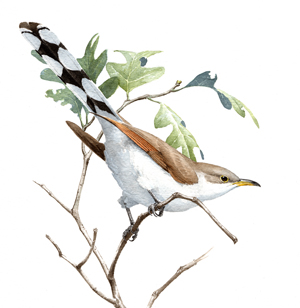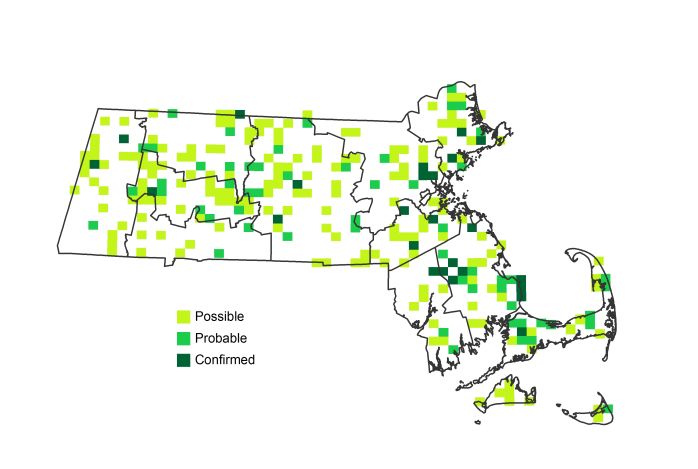Find a Bird
Yellow-billed Cuckoo
Coccyzus americanus

Somewhat local and likely increasing
“O blithe New-comer! I have heard / I hear thee and rejoice. / O Cuckoo! shall I call thee Bird / Or but a wandering Voice?” – William Wordsworth, “To the Cuckoo”
Yellow-billed Cuckoos are probably the most abundant cuckoo in the United States, but they are seemingly outnumbered in Massachusetts by Black-billed Cuckoos. Even so, Yellow-billed Cuckoos can be found in many places throughout the Commonwealth, and, unlike the Black-billed Cuckoo, their star appears to be rising. They favor wet, scrubby habitats with plenty of natural cover and insect larvae to feed upon. Yellow-billed Cuckoo populations seem to fluctuate with large changes in the availability of caterpillars – their favorite food.
Historic Status
When Massachusetts was under assault by gypsy moths in the 1890s, it was the Yellow-billed Cuckoo that joined Edward Howe Forbush in battling the scourge. In fact, in his report The Gypsy Moth: A Report of the Work of Destroying the Insect in the Commonwealth of Massachusetts, co-authored by Charles Henry Fernald, Yellow-billed Cuckoo was listed as the most helpful bird in the war against the hairy caterpillars (Forbush & Fernald 1896). But the elusiveness, secrecy, and unpredictable habits of the Yellow-billed Cuckoo have always made it hard to quantify. William Brewster (1906) saw it as a staple of the local birdlife, a denizen of apple orchards and “brushy roadsides” but also variable in population from year to year.
Atlas 1 Distribution
During Atlas 1 Yellow-billed Cuckoos were found from the Berkshires to Nantucket Island, but their distribution was notably uneven. The western hill country offered little Yellow-billed Cuckoo habitat. No more than 12% occupancy was recorded in any western ecoregion save for the Connecticut River Valley, where a matrix of old fields and hedgerows hosted cuckoos in 27% of blocks. The Worcester Plateau and Lower Worcester Plateau were not as saturated as the Connecticut River Valley, but managed several breeding reports in each region. The Coastal Plains had better than 20% occupancy, but the Bristol/Narragansett Lowlands was the real epicenter of Yellow-billed Cuckoo distribution, with cuckoos recorded in over a third of all blocks. Cuckoos were more local on the Cape and Islands but present nonetheless.
Atlas 2 Distribution and Change
Overall reports of Yellow-billed Cuckoos increased with Atlas 2, but Confirmations decreased. If nothing else, Yellow-billed Cuckoos showed apparently nomadic tendencies between the Atlases. Many ecoregions showed widespread changes. For instance, in the Coastal Plains, the species moved out of 38 blocks and into 32 others. In the Connecticut River Valley, they moved out of 11 blocks from Atlas 1 and into 11 new blocks. The Bristol/Narragansett Lowlands showed an aggregate loss of 9%, while the Berkshire Highlands, Berkshire Transition Zone, and Lower Berkshire Hills showed a marked growth of the species, with an additional 26 blocks between them boasting Yellow-billed Cuckoos. Shifting locations of major caterpillar outbreaks may have been tied to these changing occupancy patterns.
Atlas 1 Map

Atlas 2 Map

Atlas Change Map

Ecoregion Data
Atlas 1 | Atlas 2 | Change | ||||||
Ecoregion | # Blocks | % Blocks | % of Range | # Blocks | % Blocks | % of Range | Change in # Blocks | Change in % Blocks |
Taconic Mountains | 0 | 0.0 | 0.0 | 6 | 24.0 | 2.3 | 6 | 40.0 |
Marble Valleys/Housatonic Valley | 4 | 10.3 | 2.4 | 8 | 20.5 | 3.1 | 5 | 12.8 |
Berkshire Highlands | 2 | 3.6 | 1.2 | 16 | 29.1 | 6.2 | 0 | 0.0 |
Lower Berkshire Hills | 0 | 0.0 | 0.0 | 7 | 22.6 | 2.7 | 6 | 22.2 |
Vermont Piedmont | 2 | 11.8 | 1.2 | 4 | 23.5 | 1.6 | 2 | 16.7 |
Berkshire Transition | 3 | 7.9 | 1.8 | 11 | 27.5 | 4.3 | 8 | 25.8 |
Connecticut River Valley | 15 | 26.8 | 8.9 | 18 | 27.7 | 7.0 | 0 | 0.0 |
Worcester Plateau | 9 | 11.5 | 5.3 | 29 | 33.0 | 11.2 | 5 | 10.4 |
Lower Worcester Plateau | 12 | 16.2 | 7.1 | 19 | 23.8 | 7.4 | -1 | -1.9 |
S. New England Coastal Plains and Hills | 57 | 21.1 | 33.7 | 61 | 21.6 | 23.6 | -6 | -2.7 |
Boston Basin | 9 | 16.1 | 5.3 | 16 | 28.6 | 6.2 | 5 | 9.1 |
Bristol and Narragansett Lowlands | 36 | 34.0 | 21.3 | 25 | 21.9 | 9.7 | -9 | -8.9 |
Cape Cod and Islands | 20 | 14.7 | 11.8 | 38 | 26.4 | 14.7 | 13 | 10.8 |
Statewide Total | 169 | 17.4 | 100.0 | 258 | 24.9 | 100.0 | 34 | 4.1 |
Notes
The Yellow-billed Cuckoo shows significant decreasing Breeding Bird Survey trends, both in the New England/Mid-Atlantic region and the whole Eastern US.



